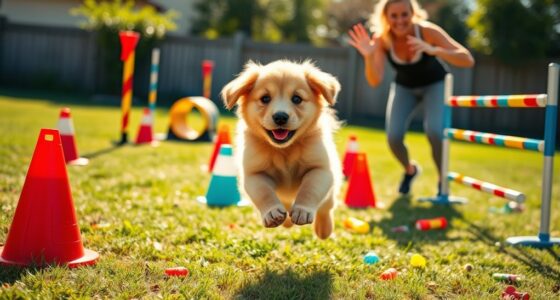The clicker’s tiny sound acts as a clear, immediate marker for the behavior you want your pet to learn, making training more precise and efficient. It helps you communicate reliably, boosting your pet’s confidence and motivation. Consistent clicking and rewarding create a predictable pattern, speeding up learning and strengthening your bond. If you want to discover how to use the clicker to transform your training sessions, keep exploring these techniques.
Key Takeaways
- The clicker provides an immediate, consistent signal that marks correct behavior clearly and reliably.
- It accelerates learning by precisely timing reinforcement, helping pets understand exactly what they did right.
- Using a clicker builds trust and positive association, boosting pet confidence and motivation.
- Consistent clicking and rewarding create a predictable pattern that enhances training effectiveness.
- The small sound helps mark specific steps in complex behaviors, improving communication and skill acquisition.

Clicker training is a highly effective and positive way to teach your pet new behaviors. The key to its success lies in the way you use the clicker as a marker of good behavior. When your pet performs the desired action, you immediately click and then reward with a treat or praise. This clear and consistent signal helps your pet understand exactly what behavior is being rewarded, making learning faster and more precise. The power of the clicker comes from its ability to create positive reinforcement, which encourages your pet to repeat the behavior. To get the best results, training consistency is essential. You need to click and reward every time your pet performs the target behavior during training sessions. This consistency helps your pet make the connection between the click, the behavior, and the reward, which speeds up the learning process.
Clicker training reinforces behaviors through consistent clicking and rewarding, speeding up learning and building trust.
Using the clicker as a consistent marker builds a clear communication channel between you and your pet. Unlike just giving treats randomly, the click provides an immediate and reliable signal that the behavior was correct. This immediacy is vital because it helps your pet associate the behavior with the reward more effectively. Over time, your pet begins to understand that the click means “Yes, that was right,” which boosts their confidence and motivation. It’s also important to keep the training sessions short and focused, ensuring your pet remains engaged and does not become overwhelmed or bored.
Another advantage of clicker training is that it helps you develop training consistency. When you always use the same sound—the click—you create a predictable pattern that your pet can quickly learn to associate with positive outcomes. This consistency reduces confusion and helps your pet learn faster. It also allows you to mark behaviors precisely, even if your timing isn’t perfect. For example, if your pet pauses before sitting, you can click at the exact moment they’re in the correct position, reinforcing that specific step in the behavior chain. Over time, this precise marking can make even complex behaviors easier to teach.
Ultimately, clicker training isn’t just about the sound; it’s about creating a consistent, positive reinforcement-based training routine. When you combine the quick, clear signals of the clicker with training consistency, your pet learns more effectively and with less frustration. It’s a gentle, enjoyable way to communicate and build trust, making training sessions more fun and rewarding for both of you. Whether you’re teaching basic commands or tackling new tricks, the power of that little click can truly change everything in your training journey. And since social media often features glimpses of pet owners and their animals, sharing your progress can also boost your motivation and connect you with a community of learners.
Frequently Asked Questions
Can Clicker Training Work for Aggressive or Fearful Animals?
You might wonder if clicker training works for aggressive or fearful animals. The answer is yes, it can be effective for aggression management and fear reduction. By using a clicker, you reinforce calm, positive behaviors, helping your pet feel safer and more confident. Consistent, gentle training encourages trust, reduces anxiety, and gradually changes their responses. With patience and proper techniques, you can transform their behavior and strengthen your bond.
How Long Does It Typically Take to See Results?
You might wonder how long it takes to see results with clicker training. With consistent timing and patience, you’ll notice progress within a few sessions, though it varies by animal. The benefits of steady practice and clear communication help build trust faster. Remember, every animal learns at its own pace, so stay committed, be patient, and celebrate small successes along the way.
What if My Pet Doesn’t Respond to the Clicker?
If your pet doesn’t respond to the clicker, don’t get discouraged. It’s common to face clicker inconsistency early on. Keep practicing with patience and persistence, ensuring you’re consistent with your timing and rewards. Sometimes, your pet might need a little more time to associate the click with positive reinforcement. Stay calm, be consistent, and gradually, your pet will start to understand that the click signals something good is happening.
Is Clicker Training Suitable for All Age Groups?
Think of training as a journey, and age considerations as your map. Clicker training suits all ages because of its training adaptability—you can tailor methods for a puppy’s curiosity or an older pet’s wisdom. It’s like turning a universal key that fits every lock, making learning engaging at any stage. So, whether your pet is young or senior, clicker training can release their potential with patience and consistency.
How Do I Troubleshoot if the Clicker Sounds Aren’t Effective?
If your clicker sounds aren’t effective, first check the clicker volume to verify it’s loud enough but not too loud. If it’s silent or inconsistent, there might be equipment issues like a faulty mechanism or dead batteries. Test your clicker with other people or replace it if needed. Consistently using the same, well-functioning clicker helps your pet associate the sound with rewards, making training more successful.
Conclusion
Now that you understand the power of clicker training, you’re equipped to build a stronger bond with your pet. Did you know that animals trained with clickers learn 60% faster than traditional methods? That little sound acts as a precise marker, boosting learning and trust. With patience and consistency, you’ll see faster progress and a happier, more responsive companion. So go ahead—click, reward, and watch your pet thrive!










